Stonne
May 15-16, 1940
As part of Germany's plan to defeat France, German committed seven of
its ten panzer divisions to a thrust through the Ardennes. Of
these seven panzer divisions, three of them headed toward Sedan.
On May 13, 1940, these three panzer divisions managed to cross
the Meuse at Sedan after the 1st Panzer Division crossed at the most
vulnerable part of the French line. The German bridgehead was
tenuous, however. There was only enough material to build one
bridge, and the allied air forces tried desperately to destroy it.
A counterattack on May 14th by the French 55th Infantry Division
supported by tanks was repulsed. Much less flexible than their
German opponents, it took the
French high command 48 hours to transmit orders to the front, but even
before the German crossing the French high command had dispatched
two divisions, the 3rd Armored and 3rd Motorised, under General
Flavigny from Reims toward Sedan.
They arrived late on May 14th. Ordered both to defend the
heights of Mont-Dieu south of Sedan and to
attack the German bridgehead, Flavigny dispersed his force
and refueled, giving the initiative to the Germans. Flavigny had
also seen a better trained armored division do poorly on exercise, so
he likely doubted the ability of his troops to competently
counterattack the Germans. Manstein's
concept from the beginning include a diversionary attack south
from
Sedan, which would confuse the French as to the German objective and
encourage the French to commit their troops south of Sedan, allowing
the panzers to advance to the English Channel with less opposition.
This German diversion was the task of the 10th Panzer Division
and the Grossdeutchland Regiment. Since French troops
could use Mont-Dieu to launch counterattacks on the German
bridgehead, the heights needed to be captured.
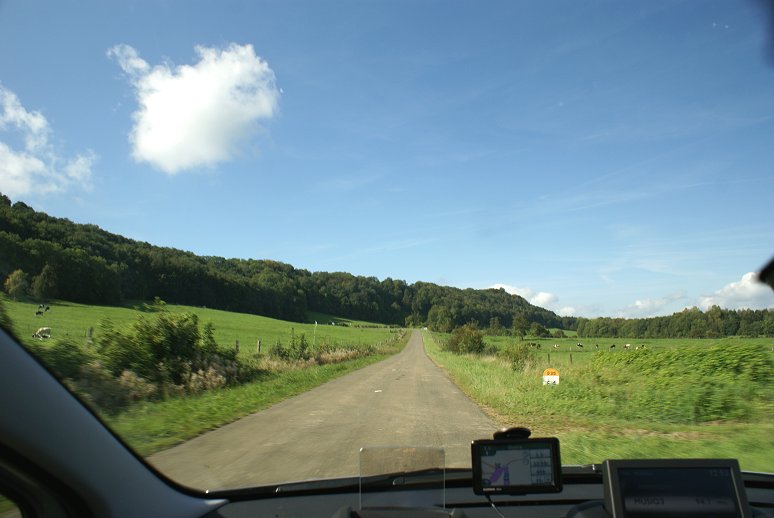
Traveling the same direction as the car here, 6 German Pz IV and
5 Pz IIs would reach an intersection in the distance and turn left to
ascend Mont-Dieu, or God Mountain.

A short German bombardment prepared the way. Ascending the hill,
the German tanks continued around this hairpin curve,
right to left, at about 0500 - then into the town of Stonne on top of
the ridge.
The hill with the calvary - Pain de Sucre, or Sugar Loaf
Hill - was an ideal place to observe the valley below. Waiting
for the Germans in the town of Stonne was a French 47mm
anti-tank gun, two 25mm AT guns, and two armored cars. (An AT gun
is below.) The anti-tank guns were effective, with only
three Panzer IIIs of the eleven German tanks making it through the
town, but follow on
German infantry captured the town. Faced with the German attack
and ordered once again to attack the Sedan bridgehead,
Flavigny now concentrated
his tanks, something that took most of the day. There were
attacks and counterattacks, and Stonne
changed hands several times.
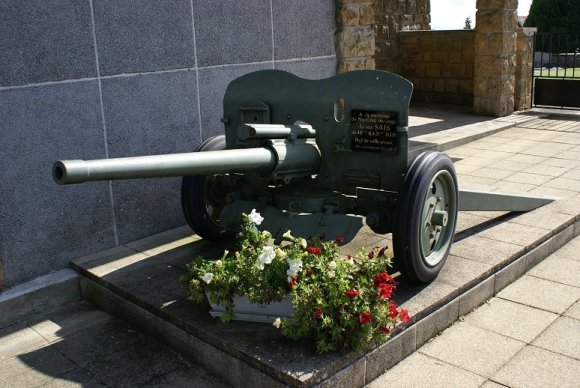
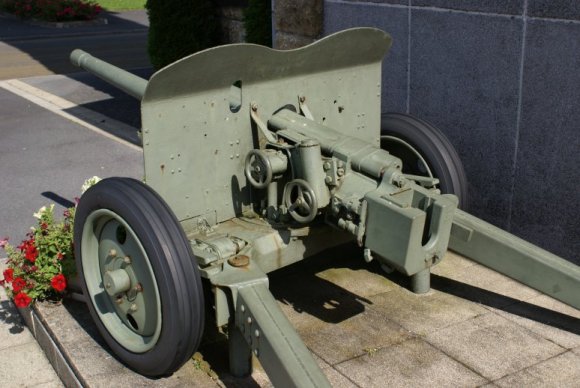
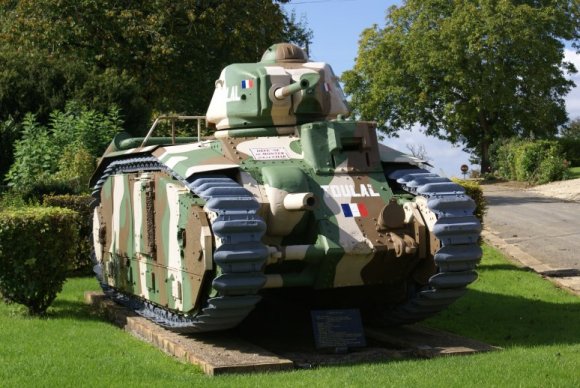
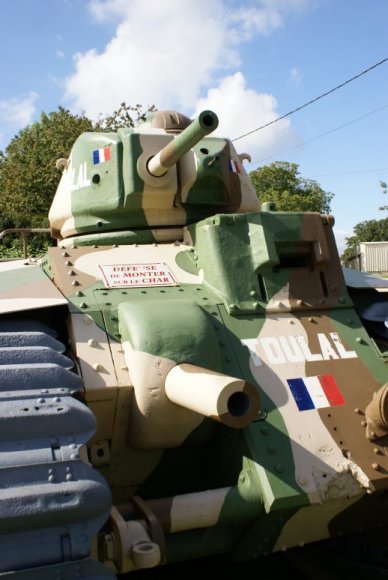
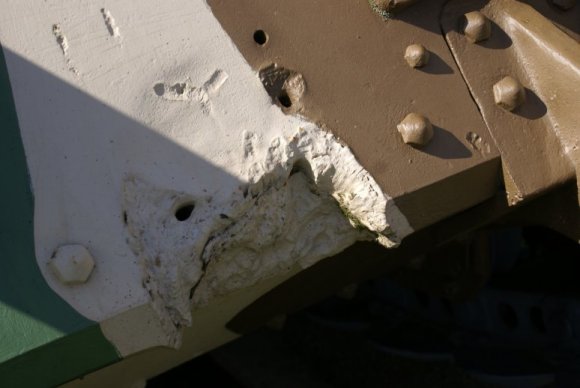
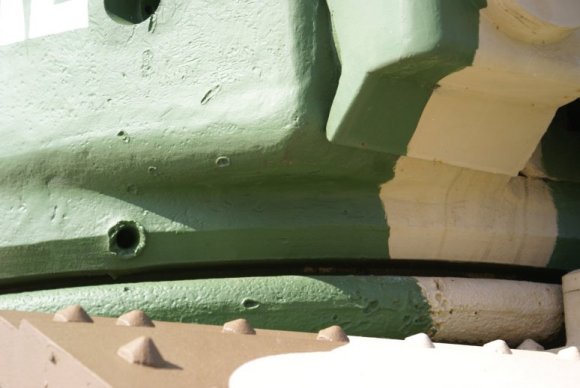
Char B
At full strength the French armored division, among other types,
boasted over 60 of the heavy Char B tanks. Due to mechanical
problems and battle casualties, only 34 were available on noon May 14th
for the planned counterattack. Unhappy with the commander of the
armored division, Flavigny had the commander of the motorised division
command both units. The fighting continued at Stonne, and by the
evening, only 29 Char Bs were available. Now there was little
hope for the planned attack on the Sedan bridgehead.
The next day the battle continued. Seven Char B tanks under
Captain Pierre Billotte, son of the general, arrived. The tanks
pictured here are of this type. Billotte's machine named "Eure".
The French vehicles had great
strengths and also some weaknesses. The lack of radios and small
gas tanks had been serious deficiencies at the Battle of Flavion near
Dinant a few days before. Another problem was the small turret,
served by just one man. Despite these issues, the French tanks
are generally regarded as superior to Germans ones in 1940.
The Char B had thick armor and two large guns, one a 47mm, the
other a 75mm. At Stonne, these attributes were just what was
needed. The Germans were shocked when they encountered the Char B.

Billotte's Rampage
The church at right is in same location as the 1940 church.
On the Morning of May 16th, seven panzers were waiting along the road here one after another
in a tight formation, ready to launch a counterattack. After a 45 minute artillery bombardment starting at 0430, Billotte
emerged on the right of the panorama leading his seven tanks in
this direction. Firing at the first and last panzers in line,
Billotte knocked them out and completely immobilized the column of
German tanks. Continuing forward, Billotte in turn knocked out each of
the remaining panzers. Seven panzers had been knocked out with no
French losses. Billotte wasn't done yet. He and his column
continued down the road on the left of the panorama.

Billotte's Rampage Continues
Moving along the road from the right of the panorama, Billotte
encountered a second
group of German tanks, the rear of which was near this intersection.
Here, on the right of the panorama, he claimed another six
panzers. He and his column continued to the left of the panorama
- to the hairpin curve.
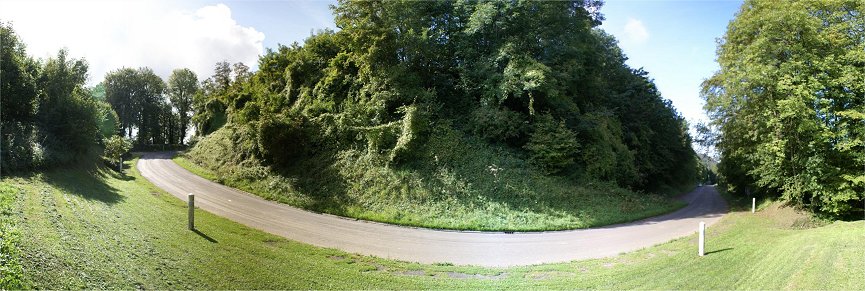
Continuing through the hairpin curve from left to
right, Billotte
knocked out a German anti-tank gun near here. Proceeding down the
slope, he destroys another German anti-tank gun, only turning around
after descending much of the hill. In all, Billotte claimed 14
panzers. His own tank had been struck 140 times but survived.
Of the tanks following him, one was missing, two broke down, and
another was stuck in a gully. French infantry secured the town
and held it until late afternoon. After the 16th, both the
Germans and the French withdrew their armored forces, with the 10th
Panzer Division continuing to the English Channel.
In light of Billotte's amazing feat of arms we can only speculate
how better trained, better lead, and more flexibly used French
armored divisions would have dealt with the German panzer divisions.
Although it is easy to take the German victory in 1940 for
granted, it was in no way pre-ordained. The result was the
product of numerous decisions on both sides, beginning before the war, all of which could have
been different.
The battle for Stonne continued, and the town changed hands a total of
seventeen
times. It was a bitter fight, called "The Verdun of 1940" by the
French. A German officer ranked the battle as memorable
as Stalingrad and Monte Cassino. In the English speaking
world, however, the battle is often neglected. But the fighting
here was vitally important because it protected the Sedan bridgehead
and allowed the massive
panzer thrust to quickly and easily reach the English Channel.
German victory in 1940 transformed the war into a global
catastrophe, and Stonne made it possible.
Copyright 2012 by John Hamill










